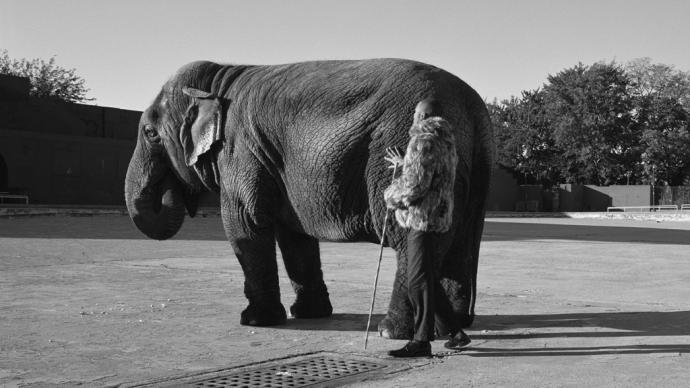from pastelegram.org, June 2011 – April 2014
Letter on the Blind, For the Use of Those Who See
The story of the six blind men and the elephant, which serves as the fulcrum for Javier Téllez’s installation at Arthouse, presents one of those platitudes that at first seems incredibly obvious but becomes chillingly prescient with a little investigation. Plenty of versions exist with plenty of diverging plot points, but the gist of the story is that six blind men are tasked with identifying an elephant by touch alone. Because the elephant is an enormous and varied animal, each man makes a wildly different guess based on which part of the elephant he approaches. The man touching the tusk imagines the animal to be a sewer pipe, while the man who touches its towering side thinks it most likely a wall. Though we know that they have not accurately described the elephant’s complete corporeal state, none of their perceptions are incorrect. The elephant’s nature is a composite made inscrutable by a limited perspective.

Javier Téllez, Letter on the Blind, For the Use of Those Who See (still), 2007; 16mm film transferred to high-definition video with sound; courtesy Arthouse at the Jones Center.
The story’s implication that we’re incapable of perceiving all but the most superficial aspects of some phenomenal object before us is scary. Or hopeful, if, like me, you find the idea of a universal perceptive limitation vaguely comforting. Rather than merely insisting on the legitimacy of diverging perspectives, the story presents us with a means to gather in our ignorance.
In Letter on the Blind, For the Use of Those Who See, Téllez abandons limitation as an essential facet of the fable. His film presents six blind people confronting an elephant in an abandoned courtyard of Brooklyn’s McCarren Park swimming pool. Accompanied by a spare panpipe-like soundtrack and filmed in black-and-white, each person approaches the elephant and feels it. After each is seated, Téllez cuts in with a slow and sustained shot of the animal’s skin, framed so tight that it seems more an abstract image—almost a contour map—while in voiceover, the person who just touched the elephant describes some personal take on experiencing blindness. These moments are arresting and dreamy, made even more so because the elephant’s breathing causes the background to shift slowly. Narrowing the viewer’s gaze to an abstract image presents a sly visual analog to the subjects’ descriptions of their condition.
In spite of its earnestness as a walk-two-moons-in-another-man’s-moccasins narrative, the film arrives at some fairly banal assertions. Each person who approaches the elephant self-narrates while touching it and walking around it slowly, but very little of what they say is substantially different from what any person might say when first encountering a magnificent and strange animal. The essential riddle at the heart of the original story—that we cannot ever know the extent of the reality presented us—is here circumvented and defanged because the documentary’s subjects already knew that they would encounter an elephant. They approach the elephant, awed by its size and the texture of its skin, but they only speak about blindness during close-up shots that are separate from their interactions; even then, these observations don’t relate to touching an elephant. The film falls short by presenting blindness as particular to the blind instead of as a condition endemic to human experience. Limitation as a condition of the original story has been made merely literal. Instead of concerning itself with what the elephant is, Téllez’s film focuses on what the elephant resembles. The difference between these figures may seem slight, but it contains all the difference between magic—replacing one thing with another—and description.

Javier Téllez, Letter on the Blind, For the Use of Those Who See (still), 2007; 16mm film transferred to high-definition video with sound; courtesy Arthouse at the Jones Center.
Invoking the classic story without corresponding to its conditions incites a kind of impatience that otherwise would not exist. When an idea so freighted with potential connections is carried out, it’s annoying that there’s little surprise or generative tension in the result. It doesn’t help that the work’s title assumes an explanatory stance, with its invocation of a letter about or from the blind sent for the use of the sighted. Téllez lists the six subjects of the film as “collaborators;” his intention is to grant them participatory status and the wall text accompanying the installation makes much of the fact that the six of them speak their names during the credits, inhabiting the piece vocally since they cannot seemingly enter it any other way. Unfortunately, this only highlights the fact that the film gives them few other opportunities to truly collaborate with Téllez. It’s ultimately unclear what use those who see are meant to make of the work.
Even so, footage of a person (sighted or not) touching an elephant for the first time is compelling stuff. The soundtrack’s restraint gives it a narrative presence; the repeated phrase that summons each person to the elephant and signals their return to their seats implies an injunction to participate in a ritual, as if gathering sensory experience is part of a longstanding human pageant. That more humble sentiment propels this film in spite of its educational trappings.